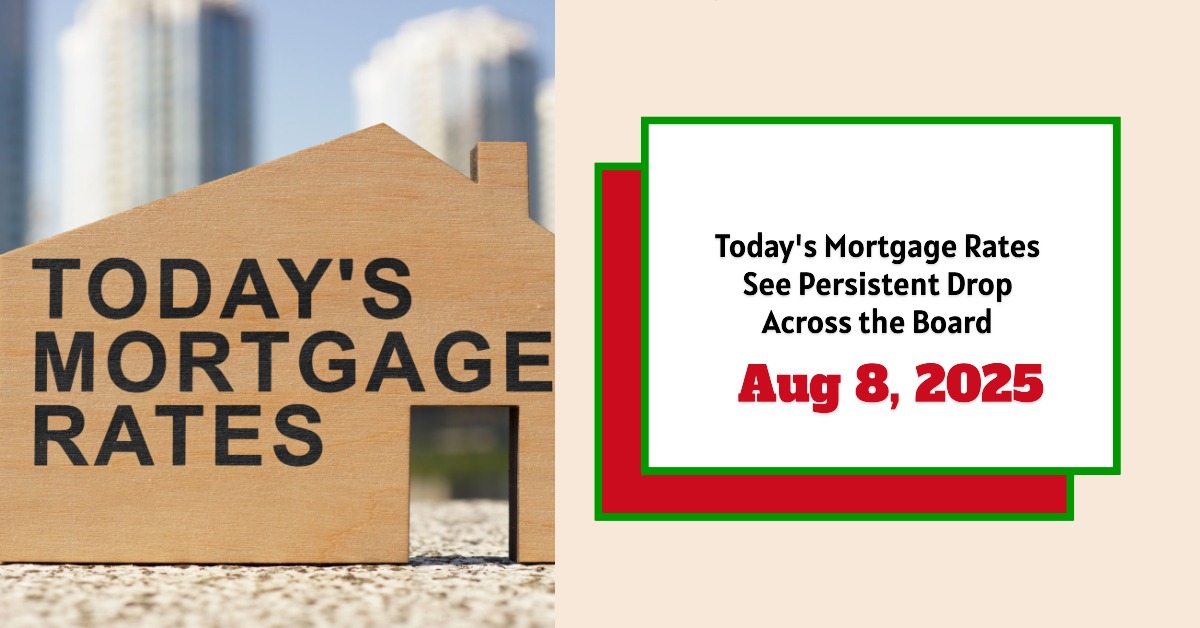As of August 8, 2025, mortgage rates have shown a small but welcome decline compared to the previous week, with the national average 30-year fixed mortgage rate dropping from 6.82% to 6.67%, according to Zillow's latest data. Similarly, refinance rates have also dropped, with the 30-year fixed refinance rate decreasing from 7.03% to 6.80%.
This slight reduction indicates some easing in borrowing costs, which could benefit homebuyers and homeowners looking to refinance. Let's dive in to find out what borrowers can expect moving forward.
Today's Mortgage Rates – August 8, 2025: Rates See Persistent Drop Across the Board
Key Takeaways
- 30-year fixed mortgage rate is currently averaging 6.67%, down 15 basis points from last week.
- Refinance rates also saw a notable decline, with the 30-year fixed refinance rate now at 6.80%, down 23 basis points.
- 15-year fixed mortgage rates remain steady at about 5.73%, while 5-year ARM rates ticked slightly higher to 7.38%.
- Government-backed loans (FHA, VA) have also experienced decreases in rates, particularly FHA 30-year fixed dropping over 1%.
- Forecasts expect mortgage rates to remain moderately high through 2025 but possibly decrease in 2026 as the Federal Reserve considers easing policies.
Current Mortgage Rates Snapshot – August 8, 2025
Here’s a detailed look at today’s mortgage rates for different loan types as per Zillow’s latest data:
| Loan Type | Rate (%) | 1 Week Change | APR (%) | 1 Week APR Change |
|---|---|---|---|---|
| 30-Year Fixed | 6.67 | Down 0.16% | 7.00 | Down 0.28% |
| 20-Year Fixed | 6.41 | Down 0.05% | 6.80 | Down 0.13% |
| 15-Year Fixed | 5.73 | Down 0.15% | 5.96 | Down 0.21% |
| 10-Year Fixed | 5.48 | Down 0.26% | 5.84 | Down 0.28% |
| 7-Year ARM | 7.08 | Down 0.14% | 7.59 | Down 0.29% |
| 5-Year ARM | 7.38 | Down 0.17% | 7.71 | Down 0.20% |
Government Loan Rates:
| Loan Type | Rate (%) | 1 Week Change | APR (%) | 1 Week APR Change |
|---|---|---|---|---|
| 30-Year Fixed FHA | 6.18 | Down 1.02% | 7.19 | Down 1.04% |
| 30-Year Fixed VA | 6.19 | Down 0.10% | 6.40 | Down 0.10% |
| 15-Year Fixed FHA | 5.31 | Down 0.20% | 6.28 | Down 0.24% |
| 15-Year Fixed VA | 5.88 | Up 0.04% | 6.23 | Up 0.05% |
Refinance Rates Trending Downwards
Refinancing remains an option with improving terms for many borrowers. The average refinance rate has similarly dropped:
| Refinance Loan Type | Rate (%) | 1 Week Change | APR (%) | 1 Week APR Change |
|---|---|---|---|---|
| 30-Year Fixed | 6.80 | Down 0.15% | — | — |
| 15-Year Fixed | 5.57 | Down 0.15% | — | — |
| 5-Year ARM | 7.77 | No Change | — | — |
This decline of 23 basis points in the 30-year fixed refinance rate over the past week is significant enough to impact monthly payments for many homeowners. For example, on a $300,000 mortgage:
- At 7.03% refinancing rate (last week), monthly principal and interest would be approximately $2,011.
- At 6.80% refinancing rate (today), monthly payments drop to about $1,954, saving about $57 monthly or roughly $684 annually.
Calculations based on standard amortization.
Related Topics:
Mortgage Rates Trends as of August 7, 2025
Mortgage Rates Predictions for the Next 30 Days: July 22-August 22
What is Driving the Movement in Mortgage Rates?
Mortgage rates do not move randomly. They are heavily influenced by economic conditions, inflation data, and, most importantly, Federal Reserve policies. The Fed controls the federal funds rate, which impacts short-term interest rates and indirectly affects long-term borrowing costs like mortgages.
- Federal Reserve Rate Decisions: In 2024, after a series of rate hikes to combat inflation, the Fed began cutting rates in late 2024, reducing the federal funds rate to about 4.25%-4.5%. Since early 2025, the Fed has paused rate changes, causing mortgage rates to stabilize near current levels.
- Inflation and Economic Growth: Inflation remains a concern, with core Personal Consumption Expenditures (PCE) around 2.7%, slightly above the Fed's target, prompting caution. Economic growth has slowed to roughly 1.2% annualized in the first half of 2025, with unemployment nudging higher, creating mixed signals.
- Long-term Treasury Yields: The 10-year Treasury yield, a benchmark for mortgage rates, sits near 4.34%. Fed communications and economic data releases continue to cause fluctuations in this yield and, by extension, mortgage interest rates.
Fed impact and economic context source details come from compiled market data and recent Fed releases.
Mortgage Rate Forecasts: What to Expect Through 2025 and Beyond
Industry experts and national organizations present coordinated yet slightly varying predictions on mortgage rates:
| Source | 2025 Prediction | 2026 Prediction |
|---|---|---|
| National Association of REALTORS® | Average around 6.4% (H2 2025) | Dip to around 6.1% |
| Realtor.com | Rate easing slowly, about 6.4% by year-end 2025 | Rates stable or easing |
| Fannie Mae | 6.5% end of 2025 | 6.1% by 2026 |
| Mortgage Bankers Association | Mid-6% range all 2025 | About 6.3% for 2026 |
These forecasts hinge on Fed decisions throughout the rest of the year. The Fed's September and December meetings are particularly important, with markets giving roughly a 47% chance for a rate cut in September.
Comparing Mortgage and Refinance Rates: Should You Act Now?
Mortgage rates and refinance rates do not always move in tandem, but recent data show a uniform trend downward. Here’s what borrowers should note:
- Home buyers benefit from the current dip in 30-year fixed rates to 6.67%, which is lower than recent 2025 highs near 7%. This slight easing can improve monthly payments and affordability.
- Refinancers especially those with loans above 7% should watch for further declines, as the refinance rate is already at 6.80%. Even a drop of a few basis points can mean hundreds in savings.
- ARM rates like 5-year and 7-year ARMs remain above 7%, signaling less appeal unless borrowers expect decreases soon.
A Personal Take on the Current Mortgage Market
From my perspective, these recent drops in mortgage and refinance rates bring cautious optimism for those waiting to purchase homes or refinance existing loans. The fact that the Fed has paused its rate hikes and may potentially lower rates later this year provides a window of opportunity for borrowers to get more favorable terms than seen before.
Historically, mortgage rates above 6.5% are considered high compared to the past decade, but given inflation pressures and economic growth, these levels might be the new normal for a while. However, the expected easing from 2026 onward reflects improving economic conditions and possible inflation control, which could bring relief back to borrowers.
Owning a home remains one of the most significant financial decisions, and even slight changes in mortgage rates can dramatically impact affordability and long-term financial health.
Capitalize Amid Rising Mortgage Rates
With mortgage rates expected to remain high in 2025, it’s more important than ever to focus on strategic real estate investments that offer stability and passive income.
Norada delivers turnkey rental properties in resilient markets—helping you build steady cash flow and protect your wealth from borrowing cost volatility.
HOT NEW LISTINGS JUST ADDED!
Speak with a seasoned Norada investment counselor today (No Obligation):
(800) 611‑3060
Also Read:
- Will Mortgage Rates Go Down in 2025: Morgan Stanley's Forecast
- Mortgage Rate Predictions 2025 from 4 Leading Housing Experts
- Mortgage Rate Predictions for the Next 3 Years: 2026, 2027, 2028
- 30-Year Fixed Mortgage Rate Forecast for the Next 5 Years
- 15-Year Fixed Mortgage Rate Predictions for Next 5 Years: 2025-2029
- Will Mortgage Rates Ever Be 3% Again in the Future?
- Mortgage Rates Predictions for Next 2 Years
- Mortgage Rate Predictions for Next 5 Years
- Mortgage Rate Predictions: Why 2% and 3% Rates are Out of Reach
- How Lower Mortgage Rates Can Save You Thousands?
- How to Get a Low Mortgage Interest Rate?
- Will Mortgage Rates Ever Be 4% Again?



